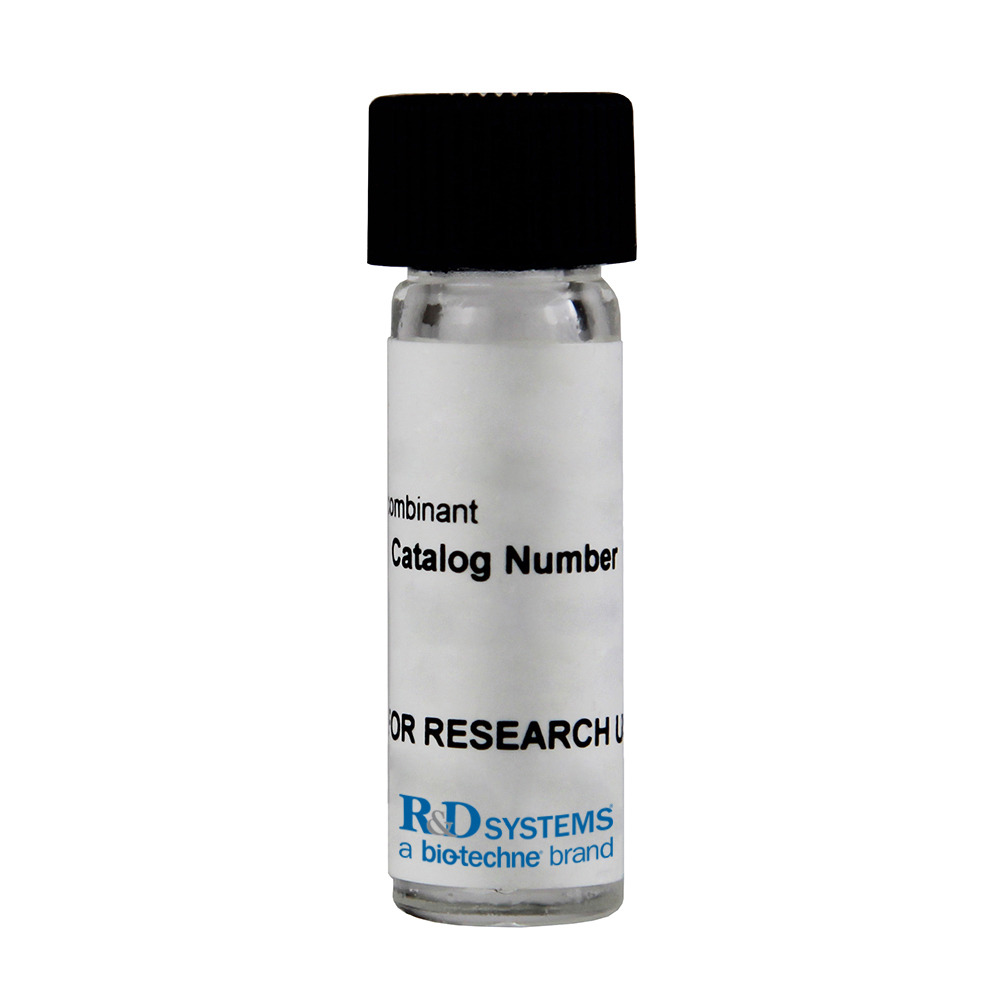Recombinant Human CHST3 Protein, CF
Recombinant Human CHST3 Protein, CF Summary
Product Specifications
Glu39-Thr479, with an N-terminal 6-His tag
Analysis
Product Datasheets
Carrier Free
CF stands for Carrier Free (CF). We typically add Bovine Serum Albumin (BSA) as a carrier protein to our recombinant proteins. Adding a carrier protein enhances protein stability, increases shelf-life, and allows the recombinant protein to be stored at a more dilute concentration. The carrier free version does not contain BSA.
In general, we advise purchasing the recombinant protein with BSA for use in cell or tissue culture, or as an ELISA standard. In contrast, the carrier free protein is recommended for applications, in which the presence of BSA could interfere.
7450-ST
| Formulation | Supplied as a 0.2 μm filtered solution in Tris and NaCl. |
| Shipping | The product is shipped with dry ice or equivalent. Upon receipt, store it immediately at the temperature recommended below. |
| Stability & Storage: | Use a manual defrost freezer and avoid repeated freeze-thaw cycles.
|
Assay Procedure
- Assay Buffer: 50 mM Tris, 50 mM MgCl2, pH 7.5
- Recombinant Human Carbohydrate Sulfotransferase 3/CHST3 (rhCHST3) (Catalog # 7450-ST)
- Universal Sulfotransferase Activity Kit (Catalog # EA003)
- Donor Substrate: Adenosine 3’-phosphate 5’-phosphosulfate lithium salt hydrate (PAPS) (Catalog # ES019)
- Acceptor Substrate: Chondroitin Sulfate (Sigma, Catalog # C6737), 50 mg/mL stock in deionized water
- 96-well Clear Plate (Costar, Catalog # 92592)
- Plate Reader (Model: SpectraMax Plus by Molecular Devices) or equivalent
- Dilute Coupling Phosphatase 3 to 100 μg/mL in Assay Buffer.
- Prepare a reaction mixture by combining 200 μL 1 mM PAPS, 100 μL 50 mg/mL chondroitin sulfate, and 50 μL 100 μg/mL Coupling Phosphatase 3. This is enough volume for 10 reactions.
- Dilute rhCHST3 to 8.33 µg/mL in Assay Buffer.
- Dilute 1 mM Phosphate Standard by adding 40 µL of the 1 mM Phosphate Standard to 360 µL of Assay Buffer for a 100 μM stock. This is the first point of the standard curve.
- Continue standard curve by performing six one-half serial dilutions of the 100 µM Phosphate stock in Assay Buffer. The standard curve has a range of 0.078 to 5.0 nmol per well.
- Load 50 µL of each dilution of the standard curve into a plate. Include a curve blank containing 50 μL of Assay Buffer.
- Load 15 µL of the 8.33 µg/mL rhCHST3 into the plate. Include a Substrate Blank containing 15 µL of Assay Buffer.
- Add 35 µL of reaction mixture to the wells, excluding the standard curve.
- Cover the plate with parafilm or a plate sealer and incubate at 37 °C for 20 minutes.
- Add 30 µL of the Malachite Green Reagent A to all wells. Mix briefly.
- Add 100 µL of deionized water to all wells. Mix briefly.
- Add 30 µL of the Malachite Green Reagent B to all wells. Mix and incubate for 20 minutes at room temperature.
- Read plate at 620 nm (absorbance) in endpoint mode.
- Calculate specific activity:
|
Specific Activity (pmol/min/µg) = |
Phosphate released* (nmol) x (1000 pmol/nmol) |
| Incubation time (min) x amount of enzyme (µg) |
*Derived from the phosphate standard curve using linear or 4-parameter fitting and adjusted for Control.
- rhCHST3: 0.125 µg
- Coupling Phosphatase 3: 0.500 μg
- PAPS: 0.4 mM
- Chondrointin Sulfate: 500 μg
Reconstitution Calculator
Background: Carbohydrate Sulfotransferase 3/CHST3
The human CHST family is comprised of 14 enzymes. All members of this family are Golgi-localized type II membrane proteins. Only the luminal and enzymatic domain is expressed in each of our recombinant CHST proteins. These enzymes transfer sulfate (i.e., sulfonate) onto the 6-O or 4-O positions of GalNAc, Gal and GlcNAc residues on glycoproteins, proteoglycans and glycolipids (1). This sulfation often creates specific epitopes that can be recognized by extracellular matrix proteins, cell surface receptors and viruses (2). CHST3, also known as chondroitin 6-O-sulfotransferase, transfers sulfate to position 6 of GalNAc residues on chondroitin sulfate (3). Chondroitin sulfate constitutes the predominant proteoglycan present in cartilage and is distributed on the surfaces of many cells and extracellular matrices. Loss of CHST3 function in human results in severe chondrodysplasia (4). CHST3 can also sulfate Gal residues of keratan sulfate and Gal residues in sialyl N-acetyllactosamine (sialyl LacNAc) oligosaccharides (5). The enzymatic activity of the recombinant human CHST3 was measured using a phosphatase-coupled sulfotransferease assay (6).
- Hemmerich, S. and Rosen, S. (2000) Glycobiology 10:849.
- Bowman, K. G. and Bertozzi, C. R. (1999) Chem. Biol. 5:447.
- Uchimura, K. et al. (2002) J. Biol. Chem. 277:1443.
- Thiele, H. et al. (2004) Proc. Natl. Acad. Sci. U. S. A. 101:10155.
- Yusa, A. et al. (2006) J. Biol. Chem. 281: 20393.
- Prather, B. et al. (2012) Anal. Biochem. 423:86.
Product Specific Notices
Coomassie is a registered trademark of Imperial Chemical Industries Ltd.FAQs
No product specific FAQs exist for this product, however you may
View all Proteins and Enzyme FAQsReviews for Recombinant Human CHST3 Protein, CF
There are currently no reviews for this product. Be the first to review Recombinant Human CHST3 Protein, CF and earn rewards!
Have you used Recombinant Human CHST3 Protein, CF?
Submit a review and receive an Amazon gift card.
$25/€18/£15/$25CAN/¥75 Yuan/¥2500 Yen for a review with an image
$10/€7/£6/$10 CAD/¥70 Yuan/¥1110 Yen for a review without an image


